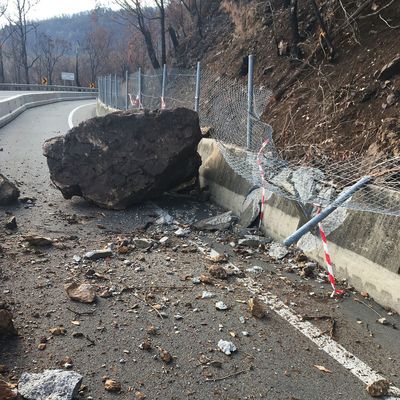By Jeremy Sollars
Potential instability of the cliff above the highway at Cunningham’s Gap will continue until at least January next year, when installation of new ‘rockfall barriers’ is scheduled to start.
Motorists, including local freight operators, have endured both ongoing inconvenience – not to mention risk to safety – for decades due to rock falls onto the Cunningham Highway through the Gap, the region’s only genuine road corridor to south-east Queensland.
The cliff both above and below the highway is notoriously unstable, prone to slippage both from heavy rain and from bushfires, both of which act to undermine large sections of rock on the near-vertical ‘upslope’.
But below the road has also been the source of problems, particularly over the last 15 years, with the highway collapsing at one stage in the vicinity of Claytons Gully on the downhill side.
The Queensland Department of Transport and Main Roads (TMR) has announced tenders for the construction of new rock barriers through the top section of the Gap will be called in July of this year, with work expected to start in January 2022.
The work is also expected to involve ‘pinning’ or removal of unstable rock sections, although TMR has declined to provide detail on that aspect of the project, despite being asked numerous times by Warwick & Stanthorpe Today and the Free Times over the past 12 to 18 months.
Either way the project will be a far cry from what many in the region have called for – a permanent solution for the Gap, either in the form of a tunnel through the mountain, a concrete cover over the road, or the construction of a new road across the range at nearby Spicers Gap, just to the south of Cunningham’s Gap.
The Spicers Gap option has been dubbed our region’s version of Toowoomba’s Second Range Crossing, with all that exists currently being goat tracks on either side of the range which are not currently linked.
Currently in place through Cunningham’s Gap are shipping containers and low concrete barriers topped with chain mesh which provide very limited containment in the event of a major landslide off the cliff.
The most recent such incident was back in January 2020 when a single boulder estimated at more than 10 tonnes – and a large number of smaller boulders and debris – smashed onto the road at the top of the Gap, causing lengthy transit delays.
That fall was caused by a disastrous combination of the late December 2019 and early 2020 bushfires and heavy rainfall, with it also being something of a miracle no motorists were injured, or worse, with a number of near-misses having taken place over the last several decades.
The work due to commence next January follows months of investigations by TMR and specialist consultants which commenced in late 2020.
Transport and Main Roads Regional Director for South Coast Paul Noonan said the 2022 project will “repair significant slope damage caused by severe bushfires in late 2019 and involved restoring lanes back to their pre-bushfire functionality on the eastern side of Cunningham’s Gap”.
“Since initial emergency works to reopen the road after the bushfires, significant activity has been undertaken on the reconstruction project,” Mr Noonan said in a statement to Warwick & Stanthorpe Today.
“Transport and Main Roads has worked with specialist geotechnical advisors to undertake comprehensive ground investigations to refine the initial concept option for repairs and determine the most appropriate treatment.
“Importantly, working through the geotechnical and structural assessments of this complex topography before starting the detailed design has meant the repair solution will provide a value for money outcome for taxpayers.”
Mr Noonan said the project will “make optimum use of the available road corridor space by using innovative rockfall barriers with catch fences up to 12 metres high built close to the upslope rock face.
“This method will also minimise construction impact to the existing lanes on this key freight route, a criterion set by TMR during the concept design phase,” he said.
“With detailed design anticipated to be completed by September 2021, we expect to seek expressions of interest for construction contractors in July, with a scheduled construction start date of January next year.
“Targeted consultation with impacted user groups, the local community, heavy vehicle industry, emergency services and other road users, will be undertaken around mid-2021 to ensure project delivery minimises travel impacts.
“As the design phase progresses, we will also continue to work through the review process with the Commonwealth to ensure the project meets their eligibility requirements and delivered a value for money outcome.
“In conjunction with a reduced speed limit of 50km/h, a temporary steel safety barrier was installed about one kilometre before Cunningham’s Gap for motorist safety until permanent slope protection works can be completed.”
TMR has previously reiterated that the Gap is “a known high rockfall area with a unique topography, therefore stabilisation works are quite complex and require detailed planning and execution”.







